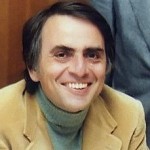Every word counts: Atlantic revisits a Carl Sagan manuscript
 Make every word count. You’ve heard that advice, right? Good writing means paying close attention to every last word.
Make every word count. You’ve heard that advice, right? Good writing means paying close attention to every last word.
As a writer, I find it educational when I get the rare chance to see how good writers work. Rebecca J. Rosen offers one such chance at Atlantic.com, where she looks into the revisions astronomer Carl Sagan made on a famous passage from his 1994 book, “Pale Blue Dot: A Vision of the Human Future in Space.”
Sagan died in 1996. In his day, he was a TV icon. A Cornell professor who created and hosted the PBS documentary series “Cosmos,” he had a distinctive and easily parodied speaking style—everyone in a certain age range has mimicked him saying “billions and billions” at some point—and he became a nerd superstar when “Cosmos” aired in 1980.
But he was also a good writer, which strikes me as a requirement for a science popularizer. The Pale Blue Dot of the book’s title is planet earth, which appeared as a speck in a photograph taken from the edge of our solar system—at Sagan’s request—by NASA’s Voyager 1 spaceprobe. Here’s the passage, as reproduced by Rosen, who calls it “perfect”:
From this distant vantage point, the Earth might not seem of any particular interest. But for us, it’s different. Consider again that dot. That’s here, that’s home, that’s us. On it everyone you love, everyone you know, everyone you ever heard of, every human being who ever was, lived out their lives. The aggregate of our joy and suffering, thousands of confident religions, ideologies, and economic doctrines, every hunter and forager, every hero and coward, every creator and destroyer of civilization, every king and peasant, every young couple in love, every mother and father, hopeful child, inventor and explorer, every teacher of morals, every corrupt politician, every “superstar,” every “supreme leader,” every saint and sinner in the history of our species lived there—on the mote of dust suspended in a sunbeam.
Rosen discusses Sagan’s edits, which she found in the Library of Congress’ Sagan archive. I’ll let you read them, but take note of how seemingly minor word changes can each make a big difference in the final text. You might not agree that every change is for the better, but every edit has an effect, because every word counts.
Even the most common word in the language, a humble three-letter article. Rosen ends by analyzing a use of that word, “the”:
Are we a mote of dust suspended in a sunbeam? Or, are we the mote of dust suspended in a sunbeam? The draft says “a,” but the voice [in a recording Sagan made] says “the.” It seems that Sagan’s verdict, in the end, was for “the.” A definite article! We are not just any mote of dust but the mote of dust.
But one detail adds a bit of ambiguity: The book agrees with the draft, not the recording, plainly calling Earth a mote of dust suspended in a sunbeam.
So, in a way, Sagan has left us with the answer that we are both. We are just a mote of dust suspended in a sunbeam. But at the same time, “for us it’s different,” Sagan says. For us, we’re the mote of dust: That’s here. That’s home. That’s us.
That’s right, three paragraphs on “a” vs. “the.”
I disagree with Rosen’s reading of Sagan’s use of “the.” I don’t think he means that earth is the mote of dust, as opposed to simply a mote of dust. I think he means earth is the mote of dust as in the one he’s been talking about.
And you know what? I’d be willing to devote a solid half hour to debating that point, the meaning of “the.” Every word counts.
* * *
Photo credit: NASA via Wikipedia

